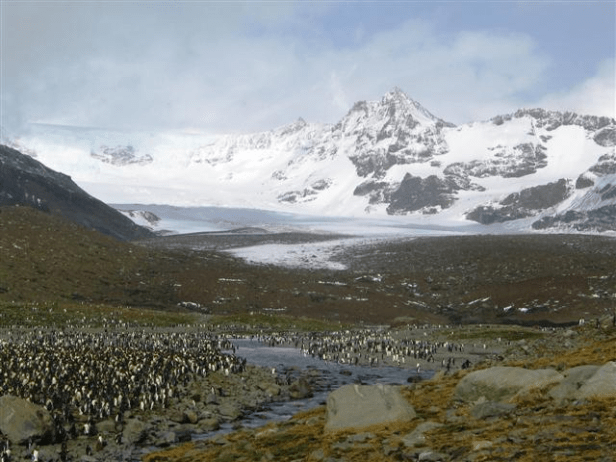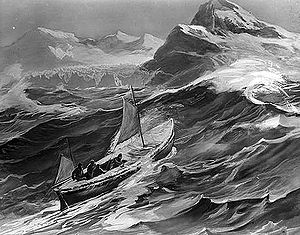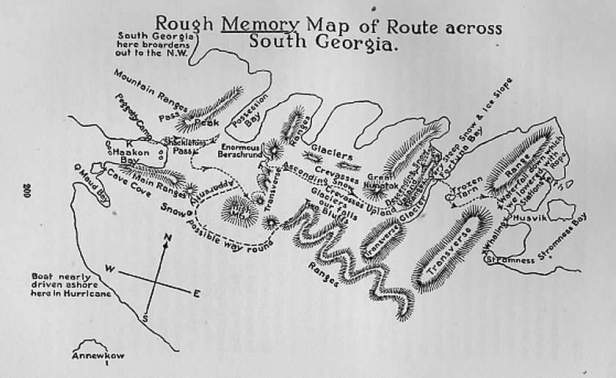2 January 2013
First landing in South Georgia: Peggoty Bluff in King Haakon Bay

Photo Credit: Melissa Rider/National Science Foundation
Our first landing on South Georgia was a completely unexpected treat, steeped in polar exploration history and on the complete opposite side of the island than most tour ships ever visit. A storm system sliding past the northeast side of the island would be washing all the traditional landing beaches on the northeast coast with heavy surf for a couple days, so, as expedition leader Ted Cheeseman put it, we had “an opportunity” to see the harsh, inhospitable, but beautiful windward southwestern coast of South Georgia. As we set our sights on Peggoty Bluff in King Haakon Bay, eyes grew wide with anticipation for its storied but seldom seen shores.Arriving at the northern tip of South Georgia before breakfast we passed first the Willis Islands and then Bird Island, where the British Antarctic Survey has a long-running seabird study. The comfortable, stable Akademik Ioffe gave us an expansive view of the glacier-draped mountain spine of South Georgia, and a thought-provoking perspective on the formidable cliffs that Shackleton’s desperate party faced after their exhausting crossing from Elephant Island near the Antarctic Peninsula. The crew of the tiny James Caird was incredibly lucky to find Cave Cove, just a notch in solid cliffs, as darkness fell. They rested and rehydrated on that tiny boulder beach for four days before they had the strength to search out a better campsite.

This photograph was published in the United States in Sir Ernest Shackleton’s book, ‘South’
Published: 1919 U.K., 1920 U.S.
Photo Credit: Likely Frank Hurley, the expedition’s photographer
http://www.ibiblio.org/ebooks/Shackleton/South/South.htm
Our ship kept a safe distance from the shallow reefs near Cave Cove but we could pick it out with binoculars. Just past Cave Cove and during breakfast, a call of “whales!” went out and a cow and calf minke whale cruised past us out of the bay. It was so warm on deck, out of the sea breeze and in the sunshine, that coats were coming off as cameras were coming out.

The Ioffe followed Shackleton’s oar-strokes deeper into King Haakon Bay to a beautiful, wide plain where Peggoty Bluff gave the explorers shelter from wind and space to stretch their legs. After an early lunch we landed our Zodiacs on the same long beach where the explorers divided up, some camping under their upturned little boat while Shackleton, Crean, and Worsley set off across the ice cap to seek rescue at the whaling stations on the leeward side of the island. This landing was an incredible way to meet South Georgia for the first time, and to get to know it anew for those who have been here before. Staff member and geology graduate student Paul Bekta was especially happy to celebrate his birthday with such an historic landing.

From: ‘South’
Published: 1919 U.K., 1920 U.S.
http://www.ibiblio.org/ebooks/Shackleton/South/South.htm
After two days at sea it was great to roam and get a feel for the land. We modern-day explorers fanned out for walks to the glacier, climbs to the top of the bluff to see nesting South Georgia Shags, and a geology hike up moraines and ridges to inspect the Cumberland Bay formation outcrops. The steep scree slopes were dotted with multicolored jackets.This was our first encounter with fur seals, which amused and delighted as they raised their heads curiously and occasionally wandered about. Lazy elephant seals lay scattered about snoring and snorting all over the beach and the flat glacial outwash plain. The area was so open that the animals were not crowded and we felt quite safe wandering among them, as long as we didn’t interfere with their occasional tiffs with each other.

Antarctic Terns floated just over our heads at the beach and South Georgia Pintails, handsome little ducks, ambled by. The sky was mostly sunny with puffy white clouds occasionally thickening into snow flurries. An icy breeze with occasional snowflakes flowed down off the glacier but it was warm enough in the sun to nap in the tussac grass like elephant seals. Here and there small groups of gorgeous King Penguins stood about in various stages of catastrophic molt, where new feathers push out the old, creating their own snow flurries of tiny white plumes across the beach.
Much of the nearshore waters on this coast are poorly charted so during supper our captain took us out around Annenkov Island on our way toward the southern tip of South Georgia where we looked forward to the dramatic Drygalski Fjord in the morning.
– Kate Spencer, Staff Naturalist; Cheesemans’ Ecology Safaris
Hello Sasja, Penny, and Elly,
I am only seeing your comments after returning from the voyage, as we did not have any internet access on board the Akademik Ioffe. These posts were sent out via a shipboard email-only account and posted by GSA staff. I would have loved to have known of the connections, and greatly enjoyed meeting all your relatives — Rob, Colin & Angela, and Stephanie. They are all great traveling companions and I wish each of you could have been there too!
–Kate
Thanks for the blog posts, Kate. Please say hello to my dad Rob Smit who is a passenger with you. I hope you’re all enjoying the trip so far and we look forward to hearing all about it in person when I catch up with him later this year.
I’m so enjoying reading these posts. If you see this Kate, please say Happy Birthday to my brother Colin who is a passenger with you. Take care. Penny
Kate we have been enjoying your comments and of course we are wish we could be there to see this natural beauty. We can’t but our daughter
Stephanie is there and we are getting her emails with much excitement.
Enjoy the Moment.